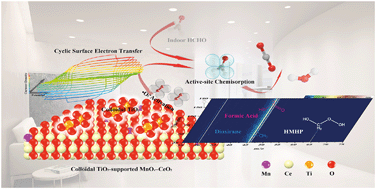Unraveling the mechanisms of room-temperature catalytic degradation of indoor formaldehyde and its biocompatibility on colloidal TiO2-supported MnOx–CeO2†
Abstract
This work overcomes the limitations in room-temperature and moisture-dependent activity of transition metal oxide-based catalysts for sub-ppm formaldehyde removal. The active site exposure and self-assembly hydrophilicity were highlighted in MnOx–CeO2 (MCO) nanospheres after the loading of colloidal 2.1 wt% TiO2 particles (TO–MCO). Approximately 57% (relative humidity = 72%) and 41% (dry air) recycling catalytic activities at 35 °C were achieved. Our results proved that surface electron transfer, which was previously weakened because of the loss of surface oxygen species and unsuitable defect-site depositions of low active ions, in the MCO catalyst was recovered via the dispersion of hydrophilic Ti–O groups. This electron transfer was also strongly correlated with the specific surface area, porosity, and oxidation states of transition metals. The greater active site exposure derived from the cyclic electron transfer eventually enhanced the HCHO chemisorption and participation of oxygen species on the surface of TO–MCO throughout the bimetallic (Mn–Ce) dismutation reactions. The abundant superoxide radicals that were activated by these oxygen species prompted a nucleophilic attack on carbonyl bonds. Direct photoionization mass spectrometry determined formic acid, dioxirane (minor), and HOCH2OOH (little) as intermediates governing the HCHO selectivity to CO2. The cytotoxicity of catalysts exposed to yeast cells was evaluated for their potential environmentally friendly application indoors.



 Please wait while we load your content...
Please wait while we load your content...